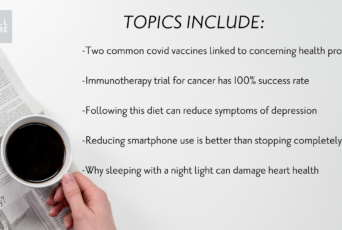Trying to stay on top of health- and wellness-related news and events can be overwhelming. It’s a lot to digest (pun intended). We saved you the trouble. Here’s what happened in August, WellBe-style.
1. Americans’ prescription drug use at record high
What: A survey by Consumer Reports found that 55 percent of Americans regularly take prescription medicine— and that we’re taking more pills today than at any other time in history.
The Details: The nationally representative survey of 1,947 adults found that Americans take an average of four prescription meds each. To put this in perspective, the total number of prescriptions filled grew by 85 percent from 1997 to 2016, whereas the population increased only by 21 percent in that time. According to Consumer Reports, the country’s harmful pill habits can be attributed to taking too many drugs, taking drugs that aren’t needed, and taking drugs prematurely (ex: drugs for borderline high blood sugar, or “prediabetes”).
A separate report by the Centers for Disease Control and Prevention (CDC) found that the number of Americans who’ve taken an antidepressant over the past month increased by 65 percent between 1999 and 2014. About one in every eight Americans reported recent antidepressant use. Women were nearly twice as likely as men to take medications.
Why Does This Matter for My Health? Unnecessary use of drugs and overuse of drugs increases your risk of a medical emergency— in 2014, almost 1.3 million people went to emergency rooms because of adverse drug effects and 124,000 died due to these events, Consumer Reports reported. In their survey, over half of people who take medications are getting these drugs from two or more healthcare providers, and more than one-third said no doc had reviewed all their meds for necessity. “The risk of adverse events increases exponentially after someone is on four or more medications,” Dr. Michael Hochman, of the Keck School of Medicine at the University of Southern California, told Consumer Reports.
The WellBe Takeaway: We’re encouraging our loved ones to take a good look at their medicine cabinets and talk to their doctors about all of their prescriptions and asking: Can I stop taking this? What are the risks of mixing these drugs? What are the medication-free alternatives to taking this drug? On the last point, Consumer Reports has 12 situations where lifestyle changes are worth trying before meds, including insomnia, low testosterone, mild depression, and heartburn.
2. Probiotic protects babies from deadly infection
What: In a big win for probiotics, public health, and infant mortality, a large study in India found that a special strain of bacteria protected babies from developing sepsis, a life-threatening bloodstream infection that kills 600,000 newborns a year.
The Details: The clinical trial in rural India has been running since 2008 and included 4,500 newborn babies—the largest such study to date. Babies were given daily doses of a probiotic with a strain of Lactobacillus plantarum for one week. Only 5.4 percent of the infants taking the probiotic developed sepsis in their first two months of life, compared to 9 percent for infants who were given the placebo. The results were so significant that an oversight panel actually stopped the trial early because giving babies the placebo would’ve been unethical. Bonus: The babies on the probiotic also had fewer pneumonias, fewer bouts of diarrhea, and fewer ear infections, The New York Times reported. The probiotic only costs $1 and study authors did not report any adverse side effects.
The study “is an absolute game-changer,” Dr. Tobias R. Kollmann, a pediatric immunologist at the University of British Columbia who was not involved in the research, told the Times. “There’s nothing we have like this in our armamentarium to prevent infections in newborns. Also, there’s how cheap it is, its ease of use— it’s oral —and its independence of pharmaceutical companies and their patent issues.”
In an unrelated study, research published in Infection and Immunity found that the probiotic Lactobacillus reuteri was effective in treating Clostridium difficile, the most common cause of diarrhea associated with the use of antibiotics. When a patient takes an antibiotic, it kills the good bacteria in the gut, giving C.diff the chance to turn into a potentially life-threatening infection. The study was done in lab cultures— not on people —but researchers noted that it is “an important example where rational design of next generation probiotics is being actively pursued to prevent disease recurrence.”
Why Does This Matter for My Health? There haven’t been many large, rigorous studies on probiotics, beneficial bacteria that can boost immunity and gut health. According to The Atlantic, this is partly because strains in commercially produced probiotics were chosen because they were easy to grow and manufacture, but not because they could colonize well in the gut, an important step. The infant study’s findings emphasize that probiotics should be matched to the illness they’re prescribed to, the study’s lead author, Pinaki Panigrahi of the University of Nebraska Medical Center, told the Times.
The WellBe Takeaway: It’s time for funding institutions to get over their prejudices about probiotics and back trials like this to find low-cost, effective ways to combat disease. The FDA classifies probiotics as drugs, which means testing is under requirements that cost time and money many researchers don’t have, STAT reported. Panigrahi pointed out that probiotics can reduce antibiotic use and slow the spread of antibiotic-resistant superbugs. We agree (stay tuned for our series on antibiotics!). We’re fortunate that the risk of sepsis for babies is lower in the U.S. than in India, but it still affects more than 75,000 children a year, per the Sepsis Alliance. There’s still a lot to learn about probiotics, but we believe eating naturally probiotic-rich foods like yogurt, kefir, sauerkraut, miso, and pickles is beneficial for our health. If we need to take antibiotics, we’re going to talk to our docs about the best probiotics to take with them.
3. Being “skinny fat” may increase cancer risk
What: Eating high-calorie, low-nutrient foods, even if you’re not overweight, may increase a woman’s risk of cancer.
The Details: In a study of more than 92,000 U.S. women, researchers found that those who were of normal weight and ate a lot of high-calorie, low-nutrient foods had a 10 percent higher risk of cancers linked to obesity. These cancers included breast, colon, ovarian, kidney, and endometrial. The women were ages 50 to 79 at the start of the trial and data was observed for 15 years. The findings were somewhat unexpected, researchers noted, because they expected the link between calorie-dense, low-nutrient diets and cancer to be strongest among obese women. Just because a woman is thin doesn’t mean they have normal blood sugar, cholesterol, or triglyceride levels, they pointed out.
Why Does This Matter for My Health? It’s easy to think if someone looks healthy, they are healthy, but being “skinny fat” is a common phenomenon. “I see these people all the time,” Dr. Daniel Neides, medical director at Cleveland Clinic’s Wellness Institute, told Time. “On the outside they look incredibly healthy, but on the inside they’re a wreck.” Even if you aren’t concerned about your weight, eating calorie-dense, low-nutrient foods can take a toll on your overall health.
The WellBe Takeaway: In line with the American Cancer Society’s recommendations, we eat with an emphasis on plant-based foods. We avoid processed foods in favor of nutrient-rich food that are good for all aspects of our health, not just maintaining a healthy weight.
4. Social isolation is a public health threat
What: A growing number of Americans are at risk for social isolation, which may increase the risk of early death more than obesity.
The Details: Looking at two large meta-analyses, researchers found that social isolation, loneliness, and living alone significantly increased the risk of premature mortality— and even more so than well-accepted risk factors like obesity. Greater social connection was associated with a 50 percent reduced risk of death.
Why Does This Matter for My Health? According to AARP’s Loneliness Study, 35 percent of adults age 45 and over suffer from chronic loneliness. The most recent U.S. census data found that more than a quarter of the U.S. population live alone, the American Psychological Association noted. “These trends suggest that Americans are becoming less socially connected and experiencing more loneliness,” researcher Julianne Holt-Lunstad, PhD, professor of psychology at Brigham Young University, said in a news release. “With an increasing aging population, the effect on public health is only anticipated to increase.”
The WellBe Takeaway: When we talked to integrative psychiatrist Dr. Ellen Vora, she said she’s most concerned about social isolation as a cause of anxiety and depression. “It’s the lack of community and isolation, and just how everyone is so far afield from how we evolved to live, and people aren’t grounded and connected in positive communities,” she told WellBe. We’re focusing on fostering our relationships and building community with friends from all stages of our lives, including grade-school classmates. The study is also a reminder to reach out to the older adults in our lives in meaningful ways, by writing letters, calling, or, even better, visiting in person.
5. Intensive lifestyle changes reverse Type 2 diabetes
What: In a study of type 2 diabetes patients, adding intensive lifestyle changes led to half of the intervention group no longer needing glucose-lowering medications.
The Details: The Danish study tested “intensive” intervention of exercise 5 to 6 times per week for 30 to 60 minutes per session (it included both endurance and resistance training) and a dietary program focused on weight loss that included lots of fruit, no processed food, high-fiber foods, and was low in saturated fats. The intervention group saw a higher drop in A1C (blood sugar) levels than the standard care group and three-quarters of the intervention group needed less diabetes medication. Only one-quarter of the standard care group lowered their meds.
Why Does This Matter for My Health? Treating Type 2 diabetes is costly and can be a lifelong complication, but this study shows that stepping up the lifestyle changes is effective in reversing the chronic disease.
The WellBe Takeaway: We’re fortunate that none of us has the diagnosis, but we’re reminded of the importance of exercise and a healthy diet as a preventative measure to chronic disease.
6. Your heart health may determine your dementia risk
What: A 25-year study of middle-aged Americans found that those with high blood pressure, diabetes, or who smoke, are more likely to develop dementia.
The Details: Though the study didn’t show a cause-and-effect relationship, researchers observed that specific heart risk factors were individually associated with dementia, HealthDay reported. These included:
-
Diabetes (77 percent increased risk of dementia).
-
High blood pressure (39 percent increased risk).
-
Pre-high blood pressure (31 percent increased risk).
-
Smoking (41 percent increased risk)









COMMENTS